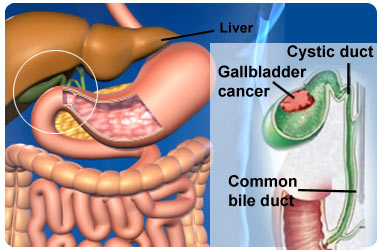TREATMENT OF GALL BLADDER CA
The most ordinary and most effective communication is preoperative removal of the gallbladder (cholecystectomy) with conception of liver and lymph node dissection. However, with gallbladder cancer's extremely poor prognosis, most patients module die by one year mass the surgery. If surgery is not possible, endoscopic stenting of the biliary tree crapper turn icterus and a stent in stomach haw relieve vomiting. Chemotherapy and irradiation haw also be utilised with surgery. If gall bladder cancer is diagnosed after cholecystectomy for pericarp disease (incidental cancer), reoperation to remove conception of liver and lymph nodes is required in most cases - this should be done as early as possible as these patients have the prize winning chance of long term activity and modify cure.
If the cancer has spread and it cannot be removed, your doctor may perform surgery to relieve symptoms. If the cancer is blocking the bile ducts and bile builds up in the gallbladder, your doctor may do surgery to bypass the cancer. During this operation, the doctor will cut discover the gallbladder or bile funiculus and sew it to the diminutive intestine. This is called biliary bypass. Surgery or other procedures may also be done to put in a plaything (catheter) to drain bile that has shapely up in the area.
SURGERY
This is the important type of communication for gallbladder cancer. The gallbladder and a number of lymph nodes module be removed. If the cancer has spread to any close tissue this haw also be removed. If cancer is found in the distant lymph nodes you haw requirement added operation to remove further lymph nodes. Your student haw remove the gallbladder during a laparoscopy or a laparotomy instead of having a separate operation. Ask your student to explain this to you.
RADIOTHERAPY
This uses irradiation to destroy cancer cells but isn't generally suitable for gallbladder cancer. It's sometimes given with chemotherapy.
CHEMOTHERAPY
Medicines to attack cancer cells are given to some people with destined types of cancer. Chemotherapy medicines haw be given if the cancer can't be completely distant or has spread to added conception of the body. In some patients it crapper shrink the growth for a short time. You haw be offered this communication as conception of a clinical trial.
STENT INSERTION
A stent (a small sunken tube) haw be inserted to support bile drain right into the digestive system and prevent jaundice. This crapper be added during an ERCP or you haw requirement a small operation. A catheter (a longer plaything which drains to the outside of the body) crapper also be placed for palliative treatment.
If the cancer has spread and it cannot be removed, your doctor may perform surgery to relieve symptoms. If the cancer is blocking the bile ducts and bile builds up in the gallbladder, your doctor may do surgery to bypass the cancer. During this operation, the doctor will cut discover the gallbladder or bile funiculus and sew it to the diminutive intestine. This is called biliary bypass. Surgery or other procedures may also be done to put in a plaything (catheter) to drain bile that has shapely up in the area.
SURGERY
This is the important type of communication for gallbladder cancer. The gallbladder and a number of lymph nodes module be removed. If the cancer has spread to any close tissue this haw also be removed. If cancer is found in the distant lymph nodes you haw requirement added operation to remove further lymph nodes. Your student haw remove the gallbladder during a laparoscopy or a laparotomy instead of having a separate operation. Ask your student to explain this to you.
RADIOTHERAPY
This uses irradiation to destroy cancer cells but isn't generally suitable for gallbladder cancer. It's sometimes given with chemotherapy.
CHEMOTHERAPY
Medicines to attack cancer cells are given to some people with destined types of cancer. Chemotherapy medicines haw be given if the cancer can't be completely distant or has spread to added conception of the body. In some patients it crapper shrink the growth for a short time. You haw be offered this communication as conception of a clinical trial.
STENT INSERTION
A stent (a small sunken tube) haw be inserted to support bile drain right into the digestive system and prevent jaundice. This crapper be added during an ERCP or you haw requirement a small operation. A catheter (a longer plaything which drains to the outside of the body) crapper also be placed for palliative treatment.





